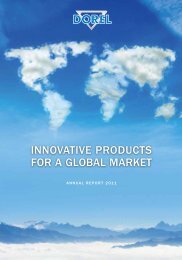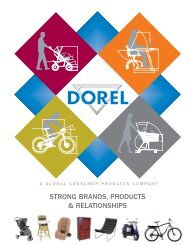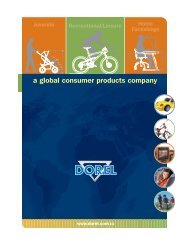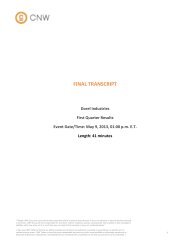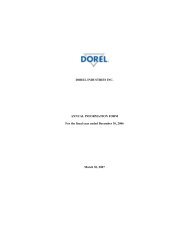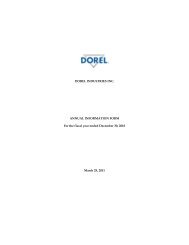2010 Annual Report - Dorel Industries
2010 Annual Report - Dorel Industries
2010 Annual Report - Dorel Industries
- No tags were found...
You also want an ePaper? Increase the reach of your titles
YUMPU automatically turns print PDFs into web optimized ePapers that Google loves.
As such, derivative financial instruments are used as a method for meeting the risk reduction objectives of the Company bygenerating offsetting cash flows related to the underlying position in respect of amount and timing of forecasted transactions.<strong>Dorel</strong> does not hold or use derivative financial instruments for trading or speculative purposes.Prior to November 1, 2009 the Company did not apply hedge accounting to foreign exchange contracts. For new foreign exchangecontracts taken after that date, the Company has designated the majority of the new foreign exchange contracts as cash flow hedgesfor which it uses hedge accounting. For the foreign exchange contracts taken prior to November 1, 2009, for which the Companyelected not to apply hedge accounting; these foreign exchange contracts, were classified as held for trading, and were marked tomarket and the associated unrealized and realized gains and losses were recorded in cost of sales.The fair values, average rates and notional amounts of derivatives and the fair values and carrying amounts of financial instrumentsare disclosed in Note 14 of the Consolidated Financial Statements.Critical Accounting EstimatesThe Consolidated Financial Statements have been prepared in accordance with Canadian GAAP. The preparation of these financialstatements requires estimates and judgments that affect the reported amounts of assets, liabilities, revenues and expenses, andrelated disclosure of contingent assets and liabilities. A complete list of all relevant accounting policies is listed in Note 3 to theConsolidated Financial Statements.The Company believes the following are the most critical accounting policies that affect <strong>Dorel</strong>’s results as presented herein and thatwould have the most material effect on the financial statements should these policies change or be applied in a different manner:• Goodwill and certain other indefinite life intangible assets: Goodwill and certain other intangible assets, such astrademarks, have indefinite useful lives and as such, are not amortized to income. Instead, the Company must determineat least once annually whether the fair values of these assets are less than their carrying value, thus indicating impairment.The Company uses the future net discounted cash flows valuation method and makes assumptions and estimates in anumber of areas, including future earnings and cash flows, the cost of capital and discount rates.• Product liability: The Company insures itself to mitigate its product liability exposure. The estimated productliability exposure is calculated by an independent actuarial firm based on historical sales volumes, past claims historyand management and actuarial assumptions. The estimated exposure includes incidents that have occurred, as well asincidents anticipated to occur on units sold prior to December 30, <strong>2010</strong>. Significant assumptions used in the actuarialmodel include management’s estimates for pending claims, product life cycle, discount rates, and the frequency andseverity of product incidents.• Pension plans and post retirement benefits: The costs of pension and other post-retirement benefits are calculatedbased on assumptions determined by management, with the assistance of independent actuarial firms and consultants.These assumptions include the long-term rate of return on pension assets, discount rates for pension and otherpost-retirement benefit obligations, expected service period, salary increases, retirement ages of employees and healthcare cost trend rates.• Income taxes: The Company follows the asset and liability method of accounting for income taxes. Under this method,future income taxes relate to the expected future tax consequences of differences between the carrying amount of balancesheet items and their corresponding tax values using the substantively enacted income tax rate, which will be in effectfor the year in which the differences are expected to reverse. A valuation allowance is recorded to reduce the carryingamount of future income tax assets to the extent that, in the opinion of management, it is more likely than not thatthe future income tax assets will not be realized. The ultimate realization of future tax assets is dependent upon thegeneration of future taxable income and tax planning strategies. Future income tax assets and liabilities are adjusted forthe effects of changes in tax laws and rates on the date of substantive enactment.<strong>Annual</strong> <strong>Report</strong> <strong>2010</strong> 19



